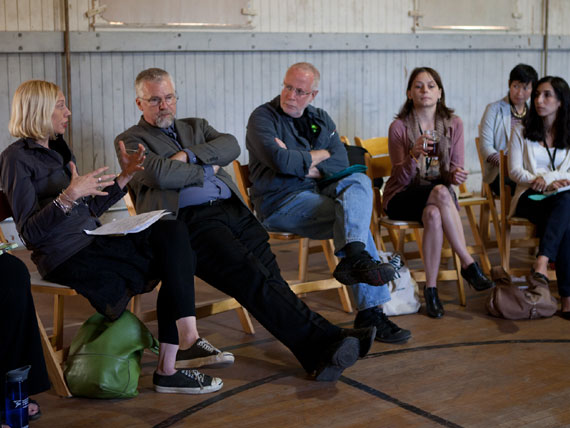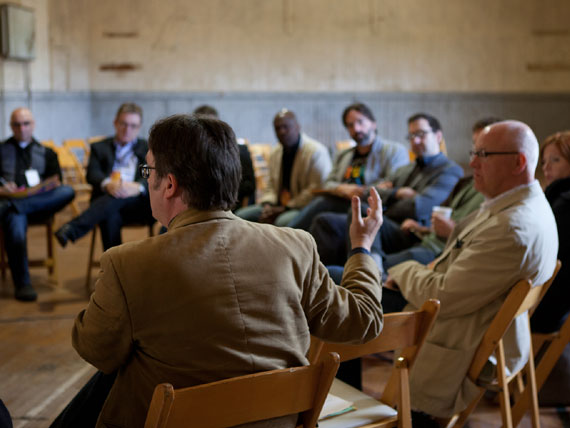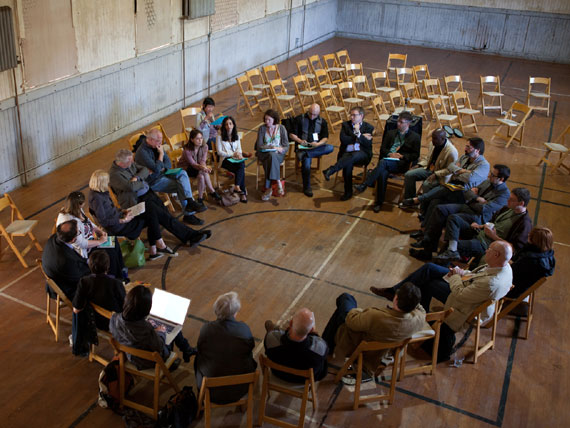Regional Collaborations, Sessions I & II
How do organizations located in cities outside of major commercial art centers envision their role and responsibility? How do they measure their scope and ambitions? And how can they support, promote, and respond to artists and their local and regional cultural ecosystem, while keeping national relationships and relevance in perspective? Session leaders will discuss these questions and explore what role collaboration might play in advancing the mission and extending the reaches and resources of our organizations.
This session presented by: Kate Hackman, Charlotte Street Foundation; Ben Heywood, Soap Factory; Chris Lynn, SPACES; Shannon Stratton, threewalls; and Steve Taylor, Second Street Gallery.
Rather than doing a formal presentation, Kate Hackman opened the floor to general discussion, while outlining some key characteristics and challenges faced by institutions outside of commercial art centers. As the conversation went on, each session leader spoke briefly about conditions in their regions.
Regional arts organizations should keep in mind that they are there to facilitate what artists want and not to collaborate for the sake of collaboration or grants. While there are potential cost savings in collaborations, there are also additional costs based on distance.
Regional alternative spaces should not be seen as stepping stones to the commercial world or more visible art markets. Regional arts organizations need to support each other and perhaps consider an “American regionalism,” which could be collaborations between the coasts or within a geographic vicinity. Regional biennials are being considered and planned.
Many organizations indicated that their artists want to show outside the area and receive national press. In addition, artists just want to meet each other. By facilitating artists meeting each other, organizations can extend the network of opportunities, as artists will invite each other to lecture, teach, and exhibit with one another.
Many organizations indicated that they bring in outside artists to exhibit. Sometimes this creates riffs within the local community, as local artists may feel entitled to exhibit in the local alternative space. Organizations sometimes need to balance the goal of creating learning experiences for local emerging artists vs. creating great exhibitions. Some organizations felt that by creating a really professional space, they could create a standard for exhibitions. Bringing in outside artists can be an opportunity for local artists to develop relationships with artists outside the area who may have more developed practices.
REGIONAL COLLABORATIONS, PART II – LATE AFTERNOON SESSION
The second instance of this session allowed for continued discussion around this same issue. The late afternoon session took the form of an intimate group where much of the conversation was dedicated to defining strategies and how to balance the benefits and obstacles to regional collaboration.
Ed Cardoni from Hallwalls indicated that in the Buffalo area some collaboration already exists. Some organizations may share overlapping facilities (e.g., wood shops, studio spaces, etc.) and administrative personnel (e.g., an educational development person, a grant writer to address and develop grants that the organizations are not already pursuing, etc.) Moreover, greater streamlining may occur as some collaborative grants allow for a consultant to work with both organizations together, rather than working with each individually. Moreover, consortiums have been formed where each collaborator received funds from an original grant, not originally based on collaboration. Collaboration can be a way to build capacity, pool resources, and expand exposure and impact.
Collaboration could take on many forms, not just capacity building. There could also be true collaboration in programming, resource development, and possibly even mergers. Alternative spaces are not necessarily interested in taking already curated shows, touring shows must be collaborative. With touring shows you can put together one catalogue, get exposure for three organizations, and have a greater impact.
Victor Davson from Aljira wondered if there was a way to organize from the bottom up. Is there a way to motivate regional organizations to organize themselves? How do regional organizations strike the balance between the benefits of centralized organization –like the Warhol Initiative–while still being able to address the issues that are pressing to regional organizations? Should there be regional gatherings?
Participants reiterated that artists want international and national exposure. They wondered if there was a way of bypassing NYC. An alternative to NYC may be a regional area, not a specific city. Cardoni thought that regionality doesn’t need to be defined geographically. While there is a practicality of working within small geographic areas, in regards to shipping work, collaboration could be based on commonality or historical similarities regardless of state borders.






